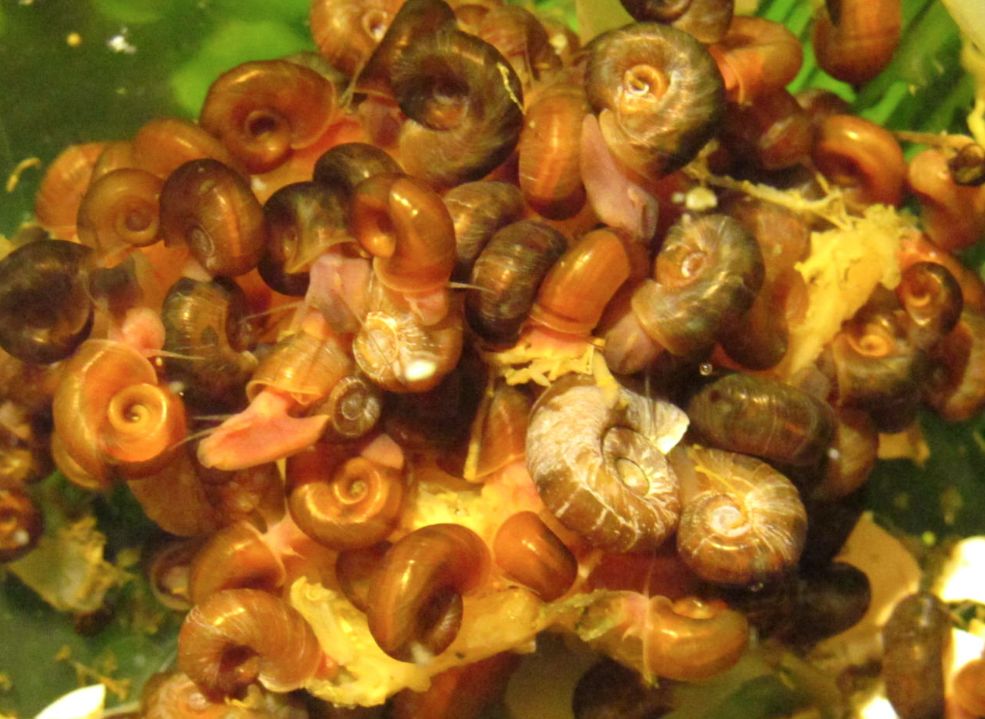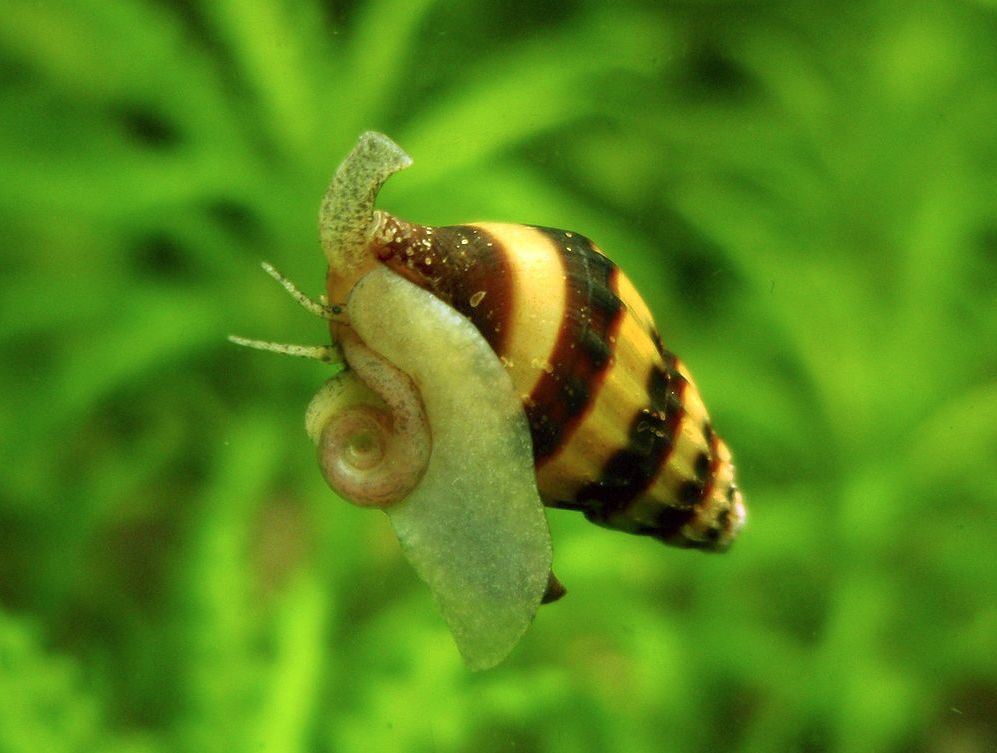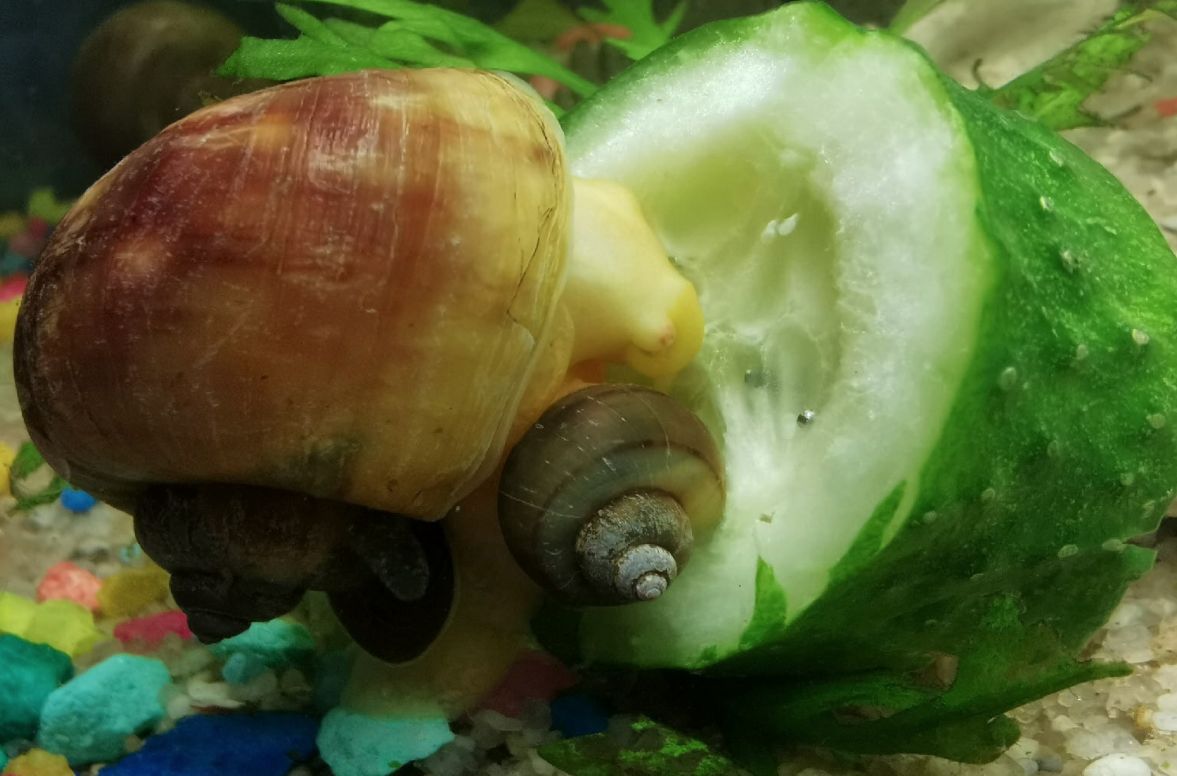Quite a lot of aquarists beginners face the problem of how to control snails population in a tank, when their number becomes too big. So, two questions rise simultaneously: how to get rid of these snails and where did they come from? Well, if you haven’t put them into the tank on purpose, they could have got into it together with the bought tank plants whose leaves might have had snails eggs on them.

Contents
How to get rid of snails in aquarium?
As it’s known many kinds are hermaphrodite species and provided with good feed just one snail may create a thousand species. At that you won’t see juveniles, since usually they hide when they are small and then, after they grow up, they start appearing in all their number.
Manual Removal
One of the simplest methods is to physically remove the snails from your tank. This is the most tiring and exhausting approach. But the majority of aquarists still use it. Usually, it’s done when cleaning the tank and the snails are removed, too. Though, this isn’t the way to get rid of snails completely, but it helps to control their population.
Assassin snails
Assassin snails (Clea helena) are known for their ability to prey on and control populations of other snails in aquariums. Predator assassin snail are sarcophagus species and they eat other kinds of snails. Recently they’ve become very popular and they are easy to buy. These are good looking snails with cone-shaped shell.
They grow to be 1-2 cm big. Helena can decrease number of snails significantly and even to get rid of them at all. If this happens, they start feeding like all other snails, however such a diet isn’t common for them. Aquarists who keep assassin snails in a tank are the ones who solve the problem of other population number once and for all and at that they always have ..snails in their tanks.
It’s important to note that while assassin snails are predators, they may not completely eradicate other snail species from your aquarium. Their effectiveness in controlling snail populations depends on factors such as the size and density of the snail population, the availability of alternative food sources, and the specific behavior and appetite of individual assassin snails. It’s recommended to carefully monitor the snail population and consider other control methods in conjunction with assassin snails for optimal results.

Traps for snails
Traps for snails are manufactured by many companies nowadays, you can always order them over the Internet. They are different in their construction, but they act all in the same way – a snail smells the feed, gets inside the trap and can’t get out. This is the good way to decrease the number, but it requires time and constant efforts
DIY Bottle Trap
A simple DIY snail trap can be made using a plastic bottle. Cut off the top portion of a plastic bottle, invert it, and place it back into the bottle as a funnel. Place bait inside the bottle, and snails will enter but won’t be able to find their way out. This cost-effective method can be effective in catching snails.
Dennerle Snail Catcher
Easily removes unwanted snails from aquarium. To remove unwanted snails, simply pull the snail catcher along the aquarium pane and transport the snails (size max. 6 mm) through the roller into the catch container. The extendable telescopic handle (max: 31 cm) saves wet hands.
Fishes that feed on snails
There are several fish species that are known to feed on snails and can help control snail populations in aquariums. Here are some common examples:
Green spotted puffer fish
The best one is green spotted puffer (Tetraodon nigroviridis), since snails are the main feed for them just like for all species of this family. This fish can crack even a hard shell of MTS snail, as for ramshorn and snails from Physidae family – they will be completely destroyed. Tetraodon nigroviridis is the most efficient fish to, but this is a rather badly behaved fish – it can attack other tank inhabitants and feed on prawns.
Clown loach
Except this fish also a freshwater clown loach eats snails. Clown loaches are popular snail-eating fish. They have a voracious appetite for snails and can consume them in large numbers. The fish is large and easily eats ramshorn, but it won’t crack the hard shell of MTS snail. The drawbacks of keeping such a fish in a tank is that it’s a large one and they should be kept in a school which isn’t always possible.
Yoyo loach
Yoyo loaches are known to eat snails and are particularly effective against Malaysian trumpet snails. They have a playful and active nature, making them an interesting addition to the aquarium.
Also paradise fish, gourami and other anabantids feed on snails, though they eat snails only if hungry. Therefore such fishes aren’t very efficient if the task.
Crustaceans also can give you a hand when dealing with snails population number in a tank. For example, Macrobrachium – it is a prawn about 6-7 cm long or more. It’s completely peaceful, but if you don’t feed it and it’s hungry and angry, it’s rather capable to eliminate all the snails.
Chemicals to kill snails in aquarium
It is more often used by beginners due to its seeming simplicity. Using chemicals to kill snails in an aquarium should be approached with caution, as some chemicals can be harmful to aquatic life, including fish, shrimp, and beneficial bacteria. Especially if in a tank you have shrimps which are very sensitive to such chemical substances, since usually they contain copper that is poisonous to all spineless species.
It’s generally recommended to explore non-chemical methods first and resort to chemical treatments only when absolutely necessary. For example, you can use:
Seachem Cupramine Copper
Seachem Cupramine is a copper-based medication commonly used in the aquarium hobby for treating various diseases in fish, such as ich. While Cupramine contains copper, which can be effective against certain parasites and snails, it is important to exercise caution when using it in an aquarium with snails.
Copper is generally toxic to most invertebrates, including snails, and can harm or even kill them. Therefore, if your goal is to eliminate snails from your aquarium, Cupramine can be effective but may also pose a risk to other desirable invertebrates, such as shrimp or snails you wish to keep.
API Liquid Super Ick Cure
While primarily used to treat ich (a parasitic disease), this medication containing formaldehyde can also help control snail populations. Follow the instructions carefully and monitor the water parameters during treatment.
No Planaria
This product is specifically designed to eliminate planaria and snails in shrimp tanks. It contains betel nut extract and is claimed to be safe for shrimp and plants when used as directed.
Tetra No More Algae
While primarily an algae control product, Tetra No More Algae contains copper sulfate, which can also help control snails. It is important to carefully follow the instructions and use it only as directed.
If you decide to use a chemical treatment, follow these guidelines:
- Choose a Snail-Safe Treatment: Look for a chemical treatment specifically designed to eliminate snails in aquariums. Read the product label carefully to ensure it is safe for your fish and other inhabitants.
- Follow Instructions: Adhere strictly to the manufacturer’s instructions regarding dosage, application, and safety precautions. Overdosing or improper use of chemicals can harm your aquarium’s ecosystem.
- Remove Sensitive Species: Before applying any chemical treatment, consider temporarily relocating sensitive species, such as shrimp or snails you wish to preserve, to a separate tank or container.
- Monitor Water Parameters: Some chemical treatments can affect water quality and may cause temporary spikes in ammonia or other compounds. Monitor your water parameters closely during and after treatment and take appropriate measures to maintain a stable and healthy environment.
- Perform Partial Water Changes: After the treatment period, perform partial water changes to help remove any residues or byproducts of the chemical treatment. This will help restore water quality and minimize the impact on your aquarium’s ecosystem.
- Consider Multiple Treatments: In some cases, a single treatment may not eliminate all snails or their eggs. You may need to repeat the treatment process after a specified period, as advised by the product instructions, to address any surviving snails or newly hatched offspring.
Always remember to prioritize the well-being of your aquarium’s inhabitants when using any chemicals. It’s important to exhaust other non-chemical control methods and carefully evaluate the necessity and potential risks before resorting to chemical treatments.
Vegetable baits
Snails love vegetables such as lettuce, cucumber or cabbage. Pieces of these vegetables can be used as a bait. In the evening put some vegetables on the plate on the tank bottom, in the morning you’ll see a number of snails there and you can remove them from the tank.
Another one way that will help you to get rid of snails is:
- Take a cucumber
- Put it into the tank (better in the evening) and turn the lights of
- In the morning you’ll see a number of shellfish on the cucumber. You’ll have to just throw them away
- If you do this about 3-4 times, you’ll take quite a lot of snails out of the tank
The only drawback of such an approach is that the water gets a bit muddy (it becomes chalky), but it’s ok, it’ll pass in 2-3 days. As well as manual removing out of the tank this approach is unlikely to help you to free the tank from snails completely, but this way you’ll be able to control their population.

Aquarium snail infestation: How to avoid
Dealing with a snail infestation in an aquarium can be frustrating, but there are several steps you can take to control and manage the population. Here’s a guide to help you address a snail infestation in your tank:
- Usually, snails get into a new tank as eggs or as adult species brought together with tank plants, decorations or when removing fishes. So, check all the plants for eggs or put the plants in the solution of “No Planaria”, that kills eggs. But even the most attentive aquarists have snails in their tanks. Snails are of no hazard to a balanced tank.
- Quarantine new fish, plants, or other additions in a separate tank for a period of time before introducing them to your main aquarium. This allows you to observe and address any potential snail infestations before they spread.
- Instead of fighting them, it’s better to control their population number, since their rapid breeding signalizes that there are some troubles in a tank.
- The main reason that causes the appearance of surplus number of snails in a tank is overfeed of tank fishes. The snails feed on fishes meals leftovers and their number grows exponentially. Snails thrive on excess food in the aquarium, so reducing the amount of food you provide can help discourage their reproduction. Feed your fish only what they can consume within a few minutes, and promptly remove any uneaten food.
- Regularly clean your aquarium by performing routine water changes and maintaining proper filtration. This helps remove excess organic matter that snails feed on and helps prevent their population from growing out of control.
- Dead plant matter, uneaten food, and decaying organic material contribute to snail population growth. Regularly remove any dead or decaying plant matter and clean substrate to prevent snails from finding additional food sources.
Snails in the tank: is it good or bad?
It is for you to decide if snails will be your tank inhabitants or not. They can both do harm and do good for a tank. So what is the role of snails in a tank balance?
Benefits of snails presence in a tank
- They are natural cleaners: they clean the bottom substrate from feed leftovers, dead fishes, fish excrements, rotten parts of tank plants, remove biological slime on water surface, fur on tank walls.
- These shellfishes play an important role in maintaining of tank biological equilibrium, and some behavior indicates the purity of tank bottom substrate and water, which helps the aquarist to notice and solve the contamination problem timely.
- Snails are beautiful in their own way and they can be a decoration element in the tank.
Drawbacks of snails presence in a tank
- When there isn’t enough of other food in a tank, snails can eat and damage tank plants.
- There may appear a problem of overpopulation (and lack of oxygen correspondingly), since the majority of snails breed rather intensively.
If you’ve decided to keep snails in your tank there are things to remember:
- You can’t bring snails from outdoor waters to your tank, because together with them you may bring infection into it.
- It’s desirable for the tank to be covered with a lid, since some snails (especially apple snail) may run away from the tank.
- Don’t overfeed the fishes, since their food leftovers are the reason why snails breed so rapidly.